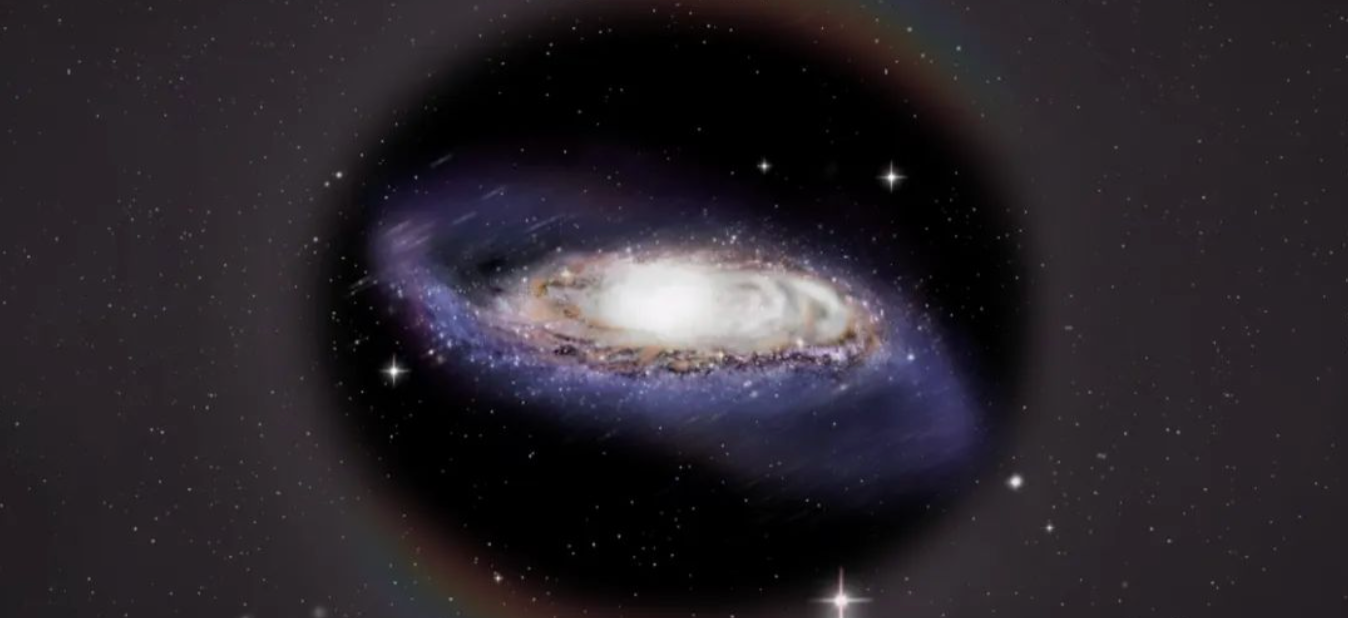Chinese Astronomers Reveal Our Galaxy‘s Cosmic Squeeze

A team of astronomers from University of Chinese Academy of Sciences has uncovered new insights into the mysterious dark matter halo surrounding our galaxy. Their groundbreaking discovery, published in the latest issue of Nature Astronomy, reveals that the dark matter halo is slightly oblate, or squished, rather than perfectly round. This discovery was made by tracking the gentle wobble of our galaxy’s disk, much like observing the tilt of a spinning top.
Imagine the Milky Way as a giant, cosmic frisbee. Over time, this frisbee doesn’t just spin smoothly—it wobbles up and down. This wobble, or warp, can tell us a lot about the invisible forces at play, especially the dark matter that makes up a significant portion of our galaxy’s mass.
Dark matter is a bit like the wind: we can’t see it, but we can see its effects. By carefully observing how the galactic frisbee wobbles, scientists can infer the shape and distribution of the dark matter.
To track this wobble, these astronomers employed an innovative “motion picture” technique. Imagine making a time-lapse video of a growing tree. By taking pictures at regular intervals, you can watch how the tree changes over time. Similarly, the motion picture technique involves observing the positions and motions of stars at different points in time to create a dynamic picture of the galaxy’s warp. This technique allows scientists to observe the changing orientation of the Milky Way’s disk warp over time, providing new insights into the galaxy’s structure.
The secret behind this technique lies in the choice of a special type of stars called classical Cepheids. These remarkable stars act as reliable cosmic timekeepers as their brightness follows a consistent and predictable pattern. Being relatively young, with an age of less than 200 million years, Cepheids exhibit a predictable variation in their brightness over time. This exceptional characteristic makes them ideal indicators for accurately measuring distances in the vast expanse of space.
To gaze these stars, the team has to rely on the LAMOST telescope. The LAMOST (Large Sky Area Multi-Object Fiber Spectroscopic Telescope), also known as the Guoshoujing Telescope, is a major national scientific facility for astronomical research located in Xinglong, China. It is an innovative telescope designed with both a large-aperture (4-meter clear aperture) and a wide field-of-view, which allows it to conduct large-scale spectroscopic surveys of celestial objects.

LAMOST uses an active optics system with segmented primary and correcting mirrors, making it the first telescope in the world to use two large segmented mirrors in one optical system. This allows it to accommodate up to 4,000 optical fibers in its focal surface, enabling it to acquire spectra of a large number of objects simultaneously.
Since its pilot survey began in 2011, LAMOST has been surveying the night sky for over a decade, producing the largest spectroscopic database of celestial objects ever constructed, with spectra for more than 10 million stars, 220,000 galaxies, and 71,000 quasars as of the latest data release. The data from LAMOST has helped astronomers deepen their understanding of the Milky Way galaxy and the broader universe.
In addition, the team also utilized data from Gaia satellite, which has been mapping the stars in our galaxy with unprecedented precision. By analyzing the positions and ages of about 2,600 Cepheid stars, the scientists created a “motion picture” of the Milky Way’s warp.
The Gaia satellite, launched by the European Space Agency, orbits the sun, gathering data on the position, distance, and motion of over a billion stars. This vast amount of data is then processed using sophisticated algorithms to produce accurate maps of our galaxy.
In this study, the researchers used Gaia’s data to measure the distances to Cepheid stars with high precision. They employed period–Wesenheit (PW) relations, which are mathematical formulas that relate a star’s brightness to its distance. This allowed them to map the three-dimensional structure of the Milky Way’s disk. By analyzing how the warp of the galactic disk changes with time, the team determined that the dark matter halo must be slightly oblate.
This finding refines our understanding of the universe’s fundamental structure. Dark matter plays a crucial role in galaxy formation, and knowing its shape can provide insights into the history and evolution of our galaxy. Think of our galaxy as a plate of jelly. If you shake the plate, the jelly wobbles. The way it wobbles can tell you about the plate’s shape and the forces acting on it.
This research not only enhances our understanding of dark matter but also sets the stage for future studies. By combining this new data with other measurements, scientists hope to trace the evolution of the dark matter halo over cosmic time, offering a window into the galaxy’s past and future.
https://www.nature.com/articles/s41550-024-02309-5





